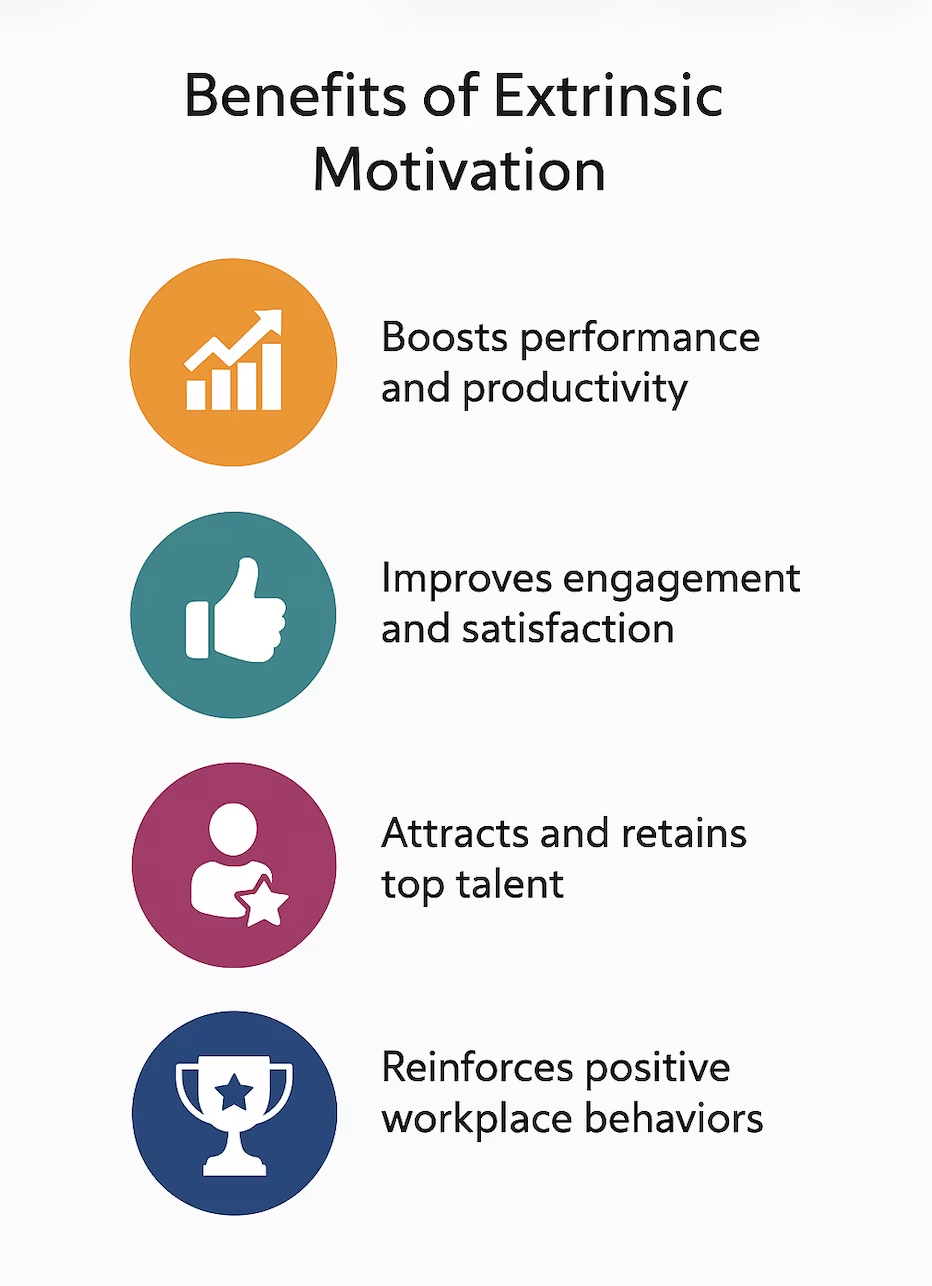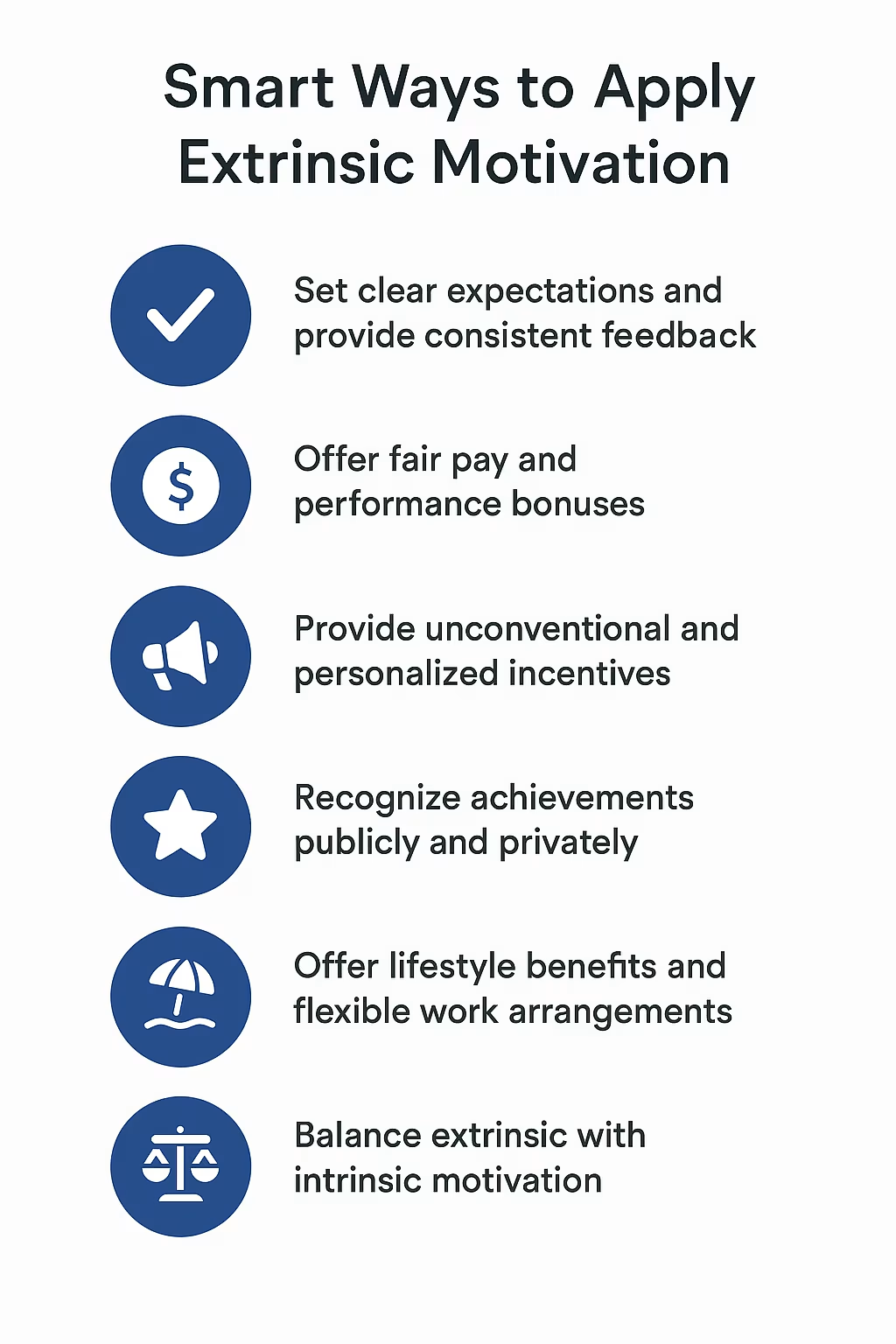Most organizations still lean heavily on pay raises, bonuses and promotions to motivate employees. And there's good reason for this approach—when done right, external incentives can boost productivity and help people power through tasks they don't find inherently engaging. Yet research suggests that money isn't always the primary driver; employees often crave recognition, clear goals and personalized perks to feel valued.
So how can you strike the right balance?
In this guide we'll unpack what extrinsic motivation is, explore its benefits and limitations, and offer practical strategies for using external rewards without undermining intrinsic motivation.
What Is Extrinsic Motivation?
Let's start with the basics. Extrinsic motivation occurs when a person acts to earn a reward or avoid a punishment rather than because the activity is inherently enjoyable. In the workplace this might mean completing a project to secure a bonus, working overtime to avoid reprimand or entering a contest to win a prize.
According to Indeed's career guide, extrinsic motivation involves being inspired to perform a task for an outcome such as earning a reward or avoiding something unpleasant. Unlike intrinsic motivation—where the behavior itself is the reward—extrinsic motivation focuses on achieving an external outcome.
Think of it this way: one employee might stay late because they love solving complex problems (intrinsic), while another stays late to earn overtime pay (extrinsic).
Examples of extrinsic motivators
Now that we understand the concept, let's look at how this plays out in real workplace scenarios. Common extrinsic motivators include:
Financial incentives: salaries, bonuses, commissions and profit‑sharing plans.
Non‑cash benefits: health insurance, retirement plans and paid time off.
Prizes and awards: gift cards, merchandise or trips for hitting targets.
Recognition: public praise, awards ceremonies or "Employee of the Month" programs.
Status and promotions: advancements in job titles or leadership positions.
Avoidance of negative consequences: working hard to avoid demotion, disciplinary action or termination.
Performance‑based pay: linking compensation to metrics like sales quotas or project milestones.
How extrinsic motivation differs from intrinsic motivation
Here's where things get interesting. Intrinsic motivation comes from within—people do a task because they enjoy it or find it meaningful. Extrinsic motivation arises from external rewards or pressures. While intrinsic motivation tends to support long‑term engagement and creativity, extrinsic incentives can be effective for tasks that are routine or not inherently enjoyable.
Consider this example: A student who studies all night to get a high score is driven by extrinsic rewards (grades and praise), whereas a student who studies because they love the subject is intrinsically motivated. Both approaches have their place, and the most effective workplaces understand how to leverage both.
Benefits of Extrinsic Motivation for Organizations
Before we dive into potential drawbacks, let's explore why external incentives remain so popular—they genuinely work when applied thoughtfully.
1. Boosts performance and productivity
This might seem obvious, but the data backs it up. Extrinsic motivation often drives people to work harder and more efficiently. Vantage Circle notes that when employees know they will receive commissions or bonuses for meeting targets, productivity increases.
Clear performance standards linked to rewards encourage employees to improve skills, take on challenging tasks and maintain high performance. Research from Harvard Business Review shows that employees receiving tangible rewards are up to 15-22 percent more efficient than their colleagues.
2. Improves engagement and satisfaction
Here's something that might surprise you: recognition and rewards can contribute to higher satisfaction beyond just the financial aspect. When employees feel their contributions are valued, they are more likely to feel appreciated and stay engaged.
Extrinsic motivation can provide clear goals and incentives that keep employees invested in their roles and company initiatives. It's not just about the reward itself—it's about the message that reward sends.
3. Attracts and retains top talent
In today's competitive job market, this benefit can't be overlooked. Competitive salaries and benefit packages are foundational motivators. Offering tangible rewards like health insurance, paid time off and flexible work arrangements helps attract candidates and retain top performers. Non‑cash benefits can enhance employees' financial security and well‑being, making them feel valued and secure in their roles.
Related read: Strategies to Boost Your Employee Retention Rate.
4. Reinforces positive workplace behaviors
This is where psychology meets practical management. Behavioral theories underpin extrinsic motivation, and understanding them can make you more effective as a leader. Operant conditioning suggests that rewards and punishments shape actions.
Positive reinforcement (rewarding good behavior), negative reinforcement (removing undesirable conditions) and punishment (introducing negative consequences) are common extrinsic tools for shaping behavior.
For example, salespeople might receive cash bonuses and public recognition for exceeding targets , while repeated poor performance could result in demotion or termination. The key is consistency and fairness in application.

Foundations and Mechanisms of Extrinsic Motivation
To use external rewards effectively, it helps to understand the psychology behind why they work.
Psychological theories
Extrinsic motivation is rooted in operant conditioning and incentive theory, where behavior is shaped by rewards and punishments. External incentives can strengthen the likelihood of desired behaviors when they follow a clear cause‑and‑effect pattern. The incentive theory emphasizes that people are motivated by the prospect of achieving a reward or avoiding a penalty; these incentives can be tangible (money) or intangible (status, praise).
Types of extrinsic rewards
Understanding the different categories of rewards can help you choose the right approach for different situations.
Extrinsic rewards are categorized into tangible and intangible. Tangible rewards include financial incentives and physical items like gift cards or merchandise. Intangible rewards focus on psychological value, such as public recognition, opportunities for career advancement and simply hearing "thank you" from colleagues or leaders.
Interestingly, a Deloitte study found that 85% of professionals want to hear "thank you" regularly, underscoring the power of intangible recognition. Sometimes the simplest gestures have the biggest impact.
Behavior modification strategies
Now let's get practical about implementation. Extrinsic motivation can be structured through positive reinforcement, negative reinforcement and punishment.
Positive reinforcement rewards desired behavior with bonuses, promotions or recognition. Negative reinforcement removes negative conditions (e.g., reducing oversight) when employees meet expectations. Punishment introduces negative consequences (demotion, reprimand) to discourage undesirable behaviors.
Understanding these mechanisms helps managers design reward systems that encourage desired actions.
Practical Strategies to Use Extrinsic Motivation Wisely
Ready to put this knowledge into action? Here are proven strategies that work in real-world settings.
1. Set clear goals and give regular feedback
This foundation step can't be skipped. Employees need to understand performance standards and what constitutes success. Fringe's workplace guide notes that setting expectations and consistency are crucial; moving the goalposts or being vague about metrics can leave employees floundering.
The solution is straightforward: clearly communicate what "good" looks like, and provide timely continuous feedback so employees know when they're on the right track. When people understand the rules of the game, they're much more likely to play it well.
2. Ensure fair pay and performance bonuses
Let's address the elephant in the room: money matters. Competitive salaries and regular raises are a baseline motivator. Performance‑based pay—such as commissions, spot bonuses or profit‑sharing—rewards employees for hitting specific goals. Setting daily, weekly and yearly targets with financial rewards can motivate employees to stretch and excel.
However, ensure that goals are attainable and aligned with broader organizational objectives. Nothing kills motivation faster than impossible targets.
3. Offer personalized, creative incentives
Here's where you can get creative and really stand out as an employer. Not all incentives need to be cash. Experiential and personalized rewards, like gift cards to an employee's favorite restaurant, extra vacation days or tickets to a concert, can be just as motivating. The key is tailoring rewards to individual preferences so everyone receives something meaningful.
Modern lifestyle benefits platforms allow employees to choose from a menu of rewards and redeem points for subscriptions, memberships or experiences. This approach recognizes that what motivates one person might not work for another.
4. Recognize achievements publicly and privately
Don't underestimate the power of recognition. Employees value communication and crave feedback. Recognition can be as simple as a public shout‑out, a personal email or a social media post celebrating a milestone. Regular recognition programs, such as "Employee of the Month," satisfy the need for appreciation and can boost morale.
According to research, 79% of employees say that receiving recognition and rewards would increase loyalty to their employers. The return on investment for genuine recognition is remarkable.
Related read: Employee Rewards and Recognition.

5. Offer lifestyle benefits and flexible work arrangements
The modern workforce values flexibility, and smart employers are listening. Flexible work options and personalized benefits can be powerful extrinsic motivators. Non‑cash benefits like health insurance, retirement plans and paid time off make employees feel valued.
Fringe's article suggests offering lifestyle spending accounts, where employees can redeem points for various perks from subscriptions to event tickets. Flexible schedules and remote work options also serve as extrinsic incentives that improve work–life balance.
6. Balance extrinsic with intrinsic motivation
This is perhaps the most critical point in this entire guide. Extrinsic rewards should complement, not replace, intrinsic drivers. Overreliance on external incentives can diminish intrinsic motivation and shift focus from quality to rewards. In some cases, people may cut corners to achieve rewards, damaging ethical standards.
Deci and Ryan's self‑determination research warns that excessive extrinsic rewards can reduce intrinsic interest. To avoid this trap, link extrinsic rewards to employees' values and career goals, help them see the significance of their roles and encourage autonomy. A balanced approach leverages external rewards for routine or less engaging tasks while nurturing autonomy, competence and relatedness to sustain long‑term engagement.

Challenges and Pitfalls
Being honest about limitations is crucial for long-term success. While extrinsic motivation is effective for driving short‑term performance, it has several important limitations:
1. Decreased intrinsic motivation: Overemphasis on external rewards can undermine internal motivation.
2. Focus on rewards over quality: Employees may prioritize earning the reward rather than delivering quality work.
3. Sustainability concerns: Extrinsic motivation often requires continuous reinforcement; without ongoing rewards, employees might lose motivation quickly.
4. Potential for unethical behavior: Linking rewards strictly to outcomes can encourage corner‑cutting or unethical practices.
Recognizing these challenges allows managers to design reward systems that drive performance while safeguarding long‑term engagement and ethical behavior. The goal is sustainable motivation, not short-term gains that create long-term problems.
Conclusion
Extrinsic motivation is a powerful tool for energizing employees and aligning behaviors with organizational goals—when used thoughtfully. External incentives such as pay, bonuses, recognition and personalized perks can boost productivity, satisfaction and engagement when tied to clear expectations and fair standards.
However, the most successful organizations understand that extrinsic rewards work best when they complement intrinsic motivation rather than replace it. By designing thoughtful reward programs and linking incentives to employees' values and career aspirations, organizations can harness the benefits of extrinsic motivation while building a resilient, engaged workforce. The key is remembering that behind every reward system are real people with individual needs, aspirations, and motivations.
ThriveSparrow's employee success platform brings together the best of extrinsic motivation through its Kudos recognition system, comprehensive 360-degree feedback, and AI-driven engagement insights that help organizations design reward systems aligned with both individual preferences and business goals.

Ready to transform how you motivate and engage your team? Start your 14-day free trial with ThriveSparrow today
Discover how the right combination of recognition, feedback, and insights can create a workplace where both extrinsic and intrinsic motivation thrive—no credit card required.
FAQs
1. What is extrinsic motivation?
Extrinsic motivation refers to performing a task to gain a reward or avoid a penalty. In the workplace it typically involves salaries, bonuses, promotions or recognition for achieving specific goals.
2. What are common examples of extrinsic motivation at work?
Examples include financial incentives (salary, bonuses), non‑cash benefits (health insurance, paid time off), prizes and awards, public recognition, promotions and performance‑based pay.
3. What are the benefits of extrinsic motivation?
External rewards can boost productivity, improve performance, enhance satisfaction and engagement and reinforce desired behaviors through positive and negative reinforcement.
4. Can extrinsic motivation undermine intrinsic motivation?
Yes. Overemphasis on external rewards can decrease intrinsic interest, shift focus from quality to reward and may require ever‑increasing incentives to sustain performance.
5. How can organizations balance extrinsic and intrinsic motivation?
Use external rewards for routine tasks and link them to employees' values and growth goals. Combine clear expectations, fair compensation, personalized perks and meaningful recognition while nurturing autonomy, competence and purpose.
















